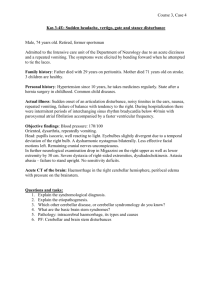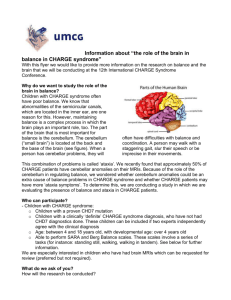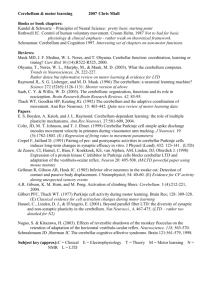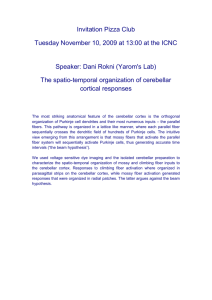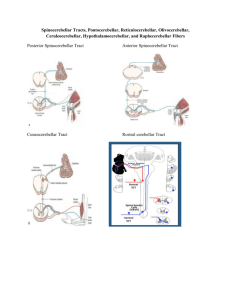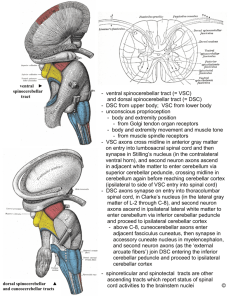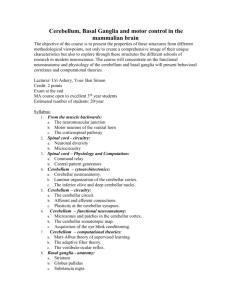Specific cerebellar reductions in children with chromosome 22q11.2 deletion syndrome
advertisement
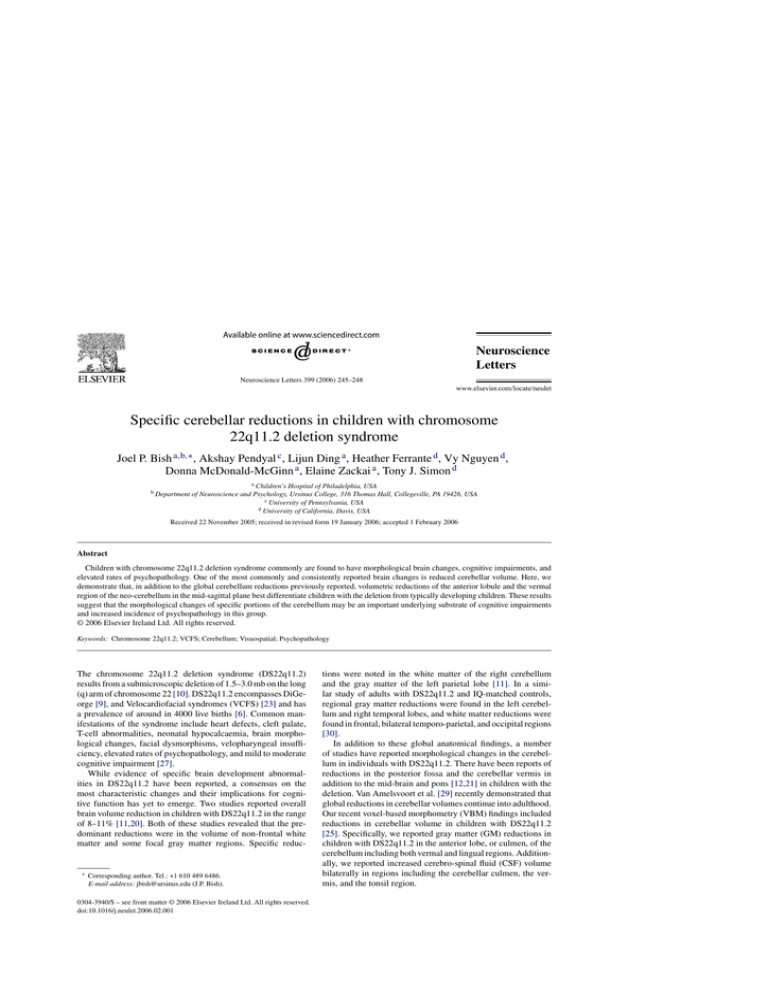
Neuroscience Letters 399 (2006) 245–248 Specific cerebellar reductions in children with chromosome 22q11.2 deletion syndrome Joel P. Bish a,b,∗ , Akshay Pendyal c , Lijun Ding a , Heather Ferrante d , Vy Nguyen d , Donna McDonald-McGinn a , Elaine Zackai a , Tony J. Simon d b a Children’s Hospital of Philadelphia, USA Department of Neuroscience and Psychology, Ursinus College, 316 Thomas Hall, Collegeville, PA 19426, USA c University of Pennsylvania, USA d University of California, Davis, USA Received 22 November 2005; received in revised form 19 January 2006; accepted 1 February 2006 Abstract Children with chromosome 22q11.2 deletion syndrome commonly are found to have morphological brain changes, cognitive impairments, and elevated rates of psychopathology. One of the most commonly and consistently reported brain changes is reduced cerebellar volume. Here, we demonstrate that, in addition to the global cerebellum reductions previously reported, volumetric reductions of the anterior lobule and the vermal region of the neo-cerebellum in the mid-sagittal plane best differentiate children with the deletion from typically developing children. These results suggest that the morphological changes of specific portions of the cerebellum may be an important underlying substrate of cognitive impairments and increased incidence of psychopathology in this group. © 2006 Elsevier Ireland Ltd. All rights reserved. Keywords: Chromosome 22q11.2; VCFS; Cerebellum; Visuospatial; Psychopathology The chromosome 22q11.2 deletion syndrome (DS22q11.2) results from a submicroscopic deletion of 1.5–3.0 mb on the long (q) arm of chromosome 22 [10]. DS22q11.2 encompasses DiGeorge [9], and Velocardiofacial syndromes (VCFS) [23] and has a prevalence of around in 4000 live births [6]. Common manifestations of the syndrome include heart defects, cleft palate, T-cell abnormalities, neonatal hypocalcaemia, brain morphological changes, facial dysmorphisms, velopharyngeal insufficiency, elevated rates of psychopathology, and mild to moderate cognitive impairment [27]. While evidence of specific brain development abnormalities in DS22q11.2 have been reported, a consensus on the most characteristic changes and their implications for cognitive function has yet to emerge. Two studies reported overall brain volume reduction in children with DS22q11.2 in the range of 8–11% [11,20]. Both of these studies revealed that the predominant reductions were in the volume of non-frontal white matter and some focal gray matter regions. Specific reduc- ∗ Corresponding author. Tel.: +1 610 489 6486. E-mail address: jbish@ursinus.edu (J.P. Bish). 0304-3940/$ – see front matter © 2006 Elsevier Ireland Ltd. All rights reserved. doi:10.1016/j.neulet.2006.02.001 tions were noted in the white matter of the right cerebellum and the gray matter of the left parietal lobe [11]. In a similar study of adults with DS22q11.2 and IQ-matched controls, regional gray matter reductions were found in the left cerebellum and right temporal lobes, and white matter reductions were found in frontal, bilateral temporo-parietal, and occipital regions [30]. In addition to these global anatomical findings, a number of studies have reported morphological changes in the cerebellum in individuals with DS22q11.2. There have been reports of reductions in the posterior fossa and the cerebellar vermis in addition to the mid-brain and pons [12,21] in children with the deletion. Van Amelsvoort et al. [29] recently demonstrated that global reductions in cerebellar volumes continue into adulthood. Our recent voxel-based morphometry (VBM) findings included reductions in cerebellar volume in children with DS22q11.2 [25]. Specifically, we reported gray matter (GM) reductions in children with DS22q11.2 in the anterior lobe, or culmen, of the cerebellum including both vermal and lingual regions. Additionally, we reported increased cerebro-spinal fluid (CSF) volume bilaterally in regions including the cerebellar culmen, the vermis, and the tonsil region. 246 J.P. Bish et al. / Neuroscience Letters 399 (2006) 245–248 In addition to these anatomical differences, children with DS22q11.2 also show a characteristic pattern of neurocognitive impairments, which may be related to the anatomical reductions mentioned above. Several studies used standardized neuropsychological evaluations to define the cognitive profile of individuals with DS22q11.2 as an overall delay in cognitive, psychomotor, and language development with an overall IQ in the range of 70–85 [13,27]. Along with these generalized impairments, more specific impairments are apparent in the domains of arithmetic and visuospatial processing [3]. More recent evidence has extended the findings of specific cognitive processing impairments in the areas of visuospatial attention and executive control in children with DS22q11.2 [5,24,26]. Additionally, impairments in visuoperceptual and executive functions have been demonstrated in adults with DS22q11.2 [18]. However, the relationship between specific cognitive impairments and volumetric differences in brain anatomy remains unclear for both children and adults with DS22q11.2. Numerous studies have demonstrated the role of the cerebellum in a variety of non-motor functions, including attentional processing shown to be dysfunctional in children with DS22q11.2 (e.g. [1,15]). However, the particular cognitive function implicated depends upon the particular focal region of the cerebellum [16]. Therefore, the objective of this paper was to investigate the location of the specific morphological changes in cerebellar volumes in children with DS22q11.2. As a starting point, these results will enable the consideration of the implications of specific cerebellar alterations for the specific cognitive impairments shown in this group. To accomplish this objective we measured and compared the areas of specific cerebellar lobules in children with DS22q11.2 and typically developing children using standard magnetic resonance imaging (MRI) region of interest tracing methods. A total of 54 children participated in this study. Of these 31 were children with DS22q11.2 whose diagnosis was confirmed via a Flourescence In Situ Hybridization (FISH) test. The mean age of the children with DS22q11.2 was 9 years, 11 months with 19 females and 12 males. The children with DS22q11.2 were recruited through their participation in the “22q and You” Clinic at the Children’s Hospital of Philadelphia. A comparison, control group of 23 children had a mean age of 10 years, 8 months with 11 females and 12 males. The control children were recruited for participation via newspaper advertisements and posted fliers. In compliance with Internal Review Board of the Children’s Hospital of Philadelphia, the parents of all children gave informed consent prior to participation. Additionally, all children involved assented to participating. Magnetic resonance imaging was performed on a Siemens MAGNETOM Vision 1.5 T scanner (Siemens Medical Solutions, Erlangen, Germany). For each subject, a high-resolution three-dimensional structural MRI was acquired using a T1weighted MP-RAGE sequence with the following parameters: repetition time (TR) 9.7 ms, echo time (TE) 4 ms, 12◦ flip angle, number of excitations = 1, matrix size = 256 × 256, slice thickness of 1.0 mm, yielding 160 sagittal slices with an in-plane resolution of 1 mm × 1 mm. Area measurement for the various cerebellar regions of interest were completed by manual tracing of regions using MRICro (v. 1.392) by a single trained tracer. For reliability purposes, a second tracer independently computed area measurements for a subset of 10 randomly selected participants. For a complete description of the regional tracing method, including pictures, see Pierson et al. [22]. For each participant, the mid-saggital slice was obtained by using the slice in which the Sylvian Aqueduct was most clearly visible. Using this slice, five distinct regions were traced manually and the area within the traced region was computed. The anterior lobe (AL) consisted of lobules I–V and continued downward to primary fissure. The superior posterior lobule (SPL) consisted of lobules VI–VII. The upper bound of the SPL was the primary fissure and the lower bound was the horizontal fissure. The inferior posterior lobule (IPL) consisted of lobules VIII–X. The upper bound of the IPL is the horizontal fissure and the lower bound is the inferior border of the cerebellum. The neo-cerebellum (NEO) consisted of lobules VI–VII and overlapped the SPL and posterior portions of the IPL. The total area of the cerebellum and the area of the tonsils of the cerebellum at the mid-sagittal slice were also measured (Fig. 1). Each measure was submitted to an ANCOVA, comparing the specific volumetric measures between the two groups, while controlling for differences in total brain volume, age, and gender. These analyses were not corrected for multiple comparisons. For the purposes of reliability of measurements, intra-class correlations were performed on the data of the 10 subjects in which 2 independent tracings were performed. Inter-rater reliability was above 90% for all measures, including the selection of the mid-sagittal slice on which all measures were taken. The results of the cerebellar comparisons between groups are reported in Table 1. The overall brain volumes for these samples were obtained as part of a previously published report [25] and were significantly reduced (p < .05) by 9.8% in children with DS22q11.2 compared to control children. To determine whether cerebellar differences were beyond those expected by this global volume reduction we used total brain volume as a covariate, in addition to age and gender. The following cerebellar mid-sagittal areas were significantly reduced in children with DS22q11.2 when controlling for total brain volume, age, and gender: total cerebellum (p = .013), anterior lobule (p = .014), neo-cerebellum (p = .015), and the tonsils (p = .010). The inferior posterior lobule trended towards a significant reduction (p = .056) in children with DS22q11.2 and the superior posterior lobule was not significantly different between groups (p = .119). To determine which of these regions were most distinctive between groups, we further submitted the data from each of the cerebellar measures to a stepwise discriminant function analysis predicting group membership (DS22q11.2 versus Controls). The discriminant function analysis revealed that the combination of the anterior lobule and the neo-cerebellum significantly predicted group membership, F(2,51) = 10.201, p < .001, with 85.9% accuracy. The other cerebellar regions were excluded in the model using a minimum partial F to enter of 3.84, and maximum partial F to remove of 2.71. In this paper we have demonstrated that, in addition to the global reductions in cerebellar tissue reported elsewhere 247 J.P. Bish et al. / Neuroscience Letters 399 (2006) 245–248 Fig. 1. Representative mid-sagittal slice from which all cerebellar regions of interest were computed. Control: left; DS22q11.2: right. [12,21,29], children with DS22q11.2 have specific reductions in various cerebellar lobules. The anterior lobule and the midline regions of the neo-cerebellum are particularly affected in this group. These regions of the vermis (VI–VII) have previously been related to attentional orienting impairments [28], which appear to be an important area of cognitive dysfunction for children with D22q11.2. However, because there are reductions in all measured regions of the cerebellum (some nonsignificant), it would be erroneous to conclude that the specific regions, shown significantly reduced here, are responsible for the cognitive impairments in this group. The abnormal cerebellar vermis morphometry shown in DS22q11.2 have been reported in a number of other disorders, such as, schizophrenia [31], autism [7], and attention deficit hyperactivity disorder [4]. In individuals with schizophrenia, altered vermal volumes have been related to psychotic symptoms [19] and to cognitive impairments [2]. A recent fMRI study comparing individuals with autism spectrum disorders found a lack of consistent activation of posterior vermal regions during spatial attention tasks [17]. Interestingly, each of these disorders has an increased prevalence among individuals with DS22q11.2. Therefore, it is quite possible that cerebellar dysmorphology in children with DS22q11.2 is a significant neural feature that plays an important role in the cognitive and behavioral phenotype of the disorder. This suggests that specific, hypothesis driven studies of that putative link would be very valuable to carry out. Since the causes and progression of the morphometric changes within the cerebellum of children with DS22q11.2 are as yet questionable, we cannot presently determine whether these reductions in childhood and adolescents will continue into adulthood, as do the behavioral features of interest. Since this paper focuses on the role that cerebellar changes in children with DS22q11.2 might play in the neurocognitive phenotype, we must at least acknowledge the fact that regions of the cerebellum, particularly the neo-cerebellum, are not fully mature until at least puberty [8]. So, although the significant results are maintained when covarying for the effects of age, we cannot rule out the possibility that brain development in children with DS22q11.2 may be on a different maturational timeline and that this contributes to group differences in regional brain volumes that are not directly related to behavioral impairments. A longitudinal investigation is necessary to rule out this potential interpretation. However, Van Amelsvoort et al. [29] did show cerebellar reductions in adults with DS22q11.2 lending support to the idea that the global cerebellar reductions shown here last into adulthood. Additionally, a recent study has demonstrated that the COMT low-activity allele contributes to prefrontal cortical volumes, cognitive decline, and the development of psychopathological symptoms during adolescence in children with DS22q11.2 [14]. A similar pattern may be at work within the cerebellum. In this study, we have replicated the previous reports of cerebellar reductions in individuals with DS22q11.2, and have extended those findings to demonstrate that along the midline, Table 1 Region of interest results (in mm2 ) Group Total cerebellum Anterior lobule Inferior posterior lobule Superior posterior lobule Neo-cerebellum Tonsils DS22q11.2 (N = 31) Controls (N = 23) Percentage of reduction 1114.09 (236.55) 1359.56 (261.89) 18.1* 362.94 (62.36) 430.39 (61.93) 15.7* 583.77 (175.1) 722.96 (204.52) 19.3 143.87 (38.95) 171.48 (45.32) 16.1 295.09 (101.49) 379.26 (129.89) 23.2* 110.52 (20.24) 128.91 (18.16) 14.3* * Significant difference between groups when covarying for age, gender, and total brain volume, p < .05. 248 J.P. Bish et al. / Neuroscience Letters 399 (2006) 245–248 the anterior lobule and the neo-cerebellar regions of the vermis are most extensively affected. These specific regions have been implicated in a number of other disorders in which individuals with DS22q11.2 have an increased incidence. Additionally, these same regions have been recently related to the proper functioning in specific cognitive domains, in which individuals with DS22q11.2 have difficulties. While strong structure/function inferences should not be drawn from this data, the results of this paper suggest further investigation into the functionality of cerebellar processing in individuals with DS22q11.2. Acknowledgments We would like to thank the children and families of the “22q and You” clinic of the Children’s Hospital of Philadelphia. References [1] N.A. Akshoomoff, E. Courchesne, A new role for the cerebellum in cognitive operations, Behav. Neurosci. 106 (1992) 731–738. [2] E. Antonova, T. Sharma, R. Morris, V. Kumari, The relationship between brain structure and neurocognition in schizophrenia: a selective review, Schizophr. Res. 70 (2004) 117–145. [3] C.E. Bearden, M.F. Woodin, P.P. Wang, E. Moss, D. McDonald-McGinn, E.H. Zackai, B. Emannuel, T.D. Cannon, The neurocognitive phenotype of the 22q11.2 deletion syndrome: selective deficit in visual–spatial memory, J. Clin. Exp. Neuropsychol. 23 (2001) 447–464. [4] P.C. Berquin, J.N. Giedd, L.K. Jacobsen, S.D. Hamburger, A.L. Krain, J.L. Rapoport, F.X. Castellanos, The cerebellum in attention deficit/hyperactivity disorder: a morphometric MRI study, Neurology 50 (1998) 1087–1093. [5] J.P. Bish, S.M. Ferrante, D. McDonald-McGinn, E. Zackai, T.J. Simon, Maladaptive conflict monitoring as evidence for executive dysfunction in children with chromosome 22q11.2 deletion syndrome, Dev. Sci. 8 (2005) 36–43. [6] J. Burn, J. Goodship, Developmental genetics of the heart, Curr. Opin. Dev. Genet. 6 (1996) 322–325. [7] E. Courchesne, R. Yyeung-Courchesne, G.A. Press, J.R. Hesselink, T. Jernigan, Hypoplasia of cerebellar vermal lobes VI and VII in autism, N. Engl. J. Med. 318 (1998) 1349–1354. [8] A. Diamond, Close interrelation of motor development and cognitive development and of the cerebellum and prefrontal cortex, Child Dev. 71 (2000) 44–56. [9] A. DiGeorge, A new concept of the cellular basis of immunity, J. Pediatr. 67 (1965) 907. [10] D.A. Driscoll, J. Salvin, B. Sellinger, M.L. Budarf, D.M. McDonaldMcGinn, E.H. Zackai, B.S. Emanuel, Prevalence of 22q11 microdeletions in DiGeorge and velocardiofacial syndromes: implications for genetic counseling and prenatal diagnosis, J. Med. Genet. 30 (1993) 813–817. [11] S. Eliez, J.E. Schmitt, C.D. White, A.L. Reiss, Children and adolescents with Velocardiofacial syndrome: a volumetric study, Am. J. Psychiatry 157 (2000) 409–415. [12] S. Eliez, J.E. Schmitt, C.D. White, V.G. Wells, A.L. Reiss, A quantitative MRI study of posterior fossa development in velocardiofacial syndrome, Biol. Psychiatry 49 (2001) 540–546. [13] M. Gerdes, C. Solot, P.P. Wang, E. Moss, D. LaRossa, P. Randall, E. Goldmuntz, B.J. Clark, D.A. Driscoll, A. Jawad, B.S. Emanuel, D.M. McDonald-McGinn, M.L. Batshaw, E.H. Zackai, Cognitive and behavior profile of preschool children with chromosome 22q11.2 deletion, Am. J. Med. Genet. 85 (1999) 127–133. [14] D. Gothelf, S. Eliez, T. Thompson, C. Hinard, L. Penniman, C. Feinstein, H. Kwon, S. Jin, B. Jo, S.E. Antonarakis, M. Morris, A. Reiss, COMT genotype predicts longitudinal cognitive decline and psychosis in 22q11.2 deletion syndrome, Nat. Neurosci. 8 (2005) 1500– 1502. [15] B. Gottwald, Z. Mihajlovic, B. Wilde, H.M. Mehdorn, Does the cerebellum contribute to specific aspects of attention? Neuropsychologia 41 (2003) 1452–1460. [16] B. Gottwald, B. Wilde, Z. Mihajlovic, H.M. Mehdorn, Evidence for distinct cognitive deficits after focal cerebellar lesions, J. Neurol. Neurosurg. Psychiatry 75 (2004) 1524–1531. [17] F. Haist, M. Adamo, M. Westerfield, E. Courchesne, J. Townsend, The functional neuroanatomy of spatial attention in autism spectrum disorder, Dev. Neuropsychol. 27 (2005) 425–458. [18] J.C. Henry, T. Van Amelsvoort, R.G. Morris, M.J. Owen, D.G.M. Murphy, K.C. Murphy, An investigation of the neuropsychological profile in adults with veelo-cardio-facial syndrome, Neuropsychologia 40 (2002) 471–478. [19] T. Ichimiya, Y. Okubo, T. Suhara, Y. Sudo, Reduced volume of the cerebellar vermis in neuroleptic-naı̈ve schizophrenia, Biol. Psychiatry 49 (2001) 20–27. [20] W.R. Kates, C.P. Burnette, E.W. Jabs, J. Rutberg, A.M. Murphy, M. Grados, M. Geraghty, W.E. Kaufmann, G.D. Pearlson, Regional cortical white matter reductions in velocariofacial syndrome: a volumetric MRI analysis, Biol. Psychiatry 49 (2001) 677–684. [21] R.J. Mitnick, J.A. Bello, R.J. Shprintzen, Brain anomalies in velo-cardiofacial syndrome, Am. J. Med. Genet. (Neuropsychiatr. Genet.) 54 (1994) 100–106. [22] R. Pierson, P.W. Corson, L.L. Sears, D. Alicata, V. Magnotta, D. Oleary, N.C. Andraesen, Manual and semiautomated measurement of cerebellar subregions on MR images, Neuroimage 17 (2002) 61–76. [23] R.J. Shprintzen, R.B. Goldberg, M.L. Lewin, E.J. Sidoti, M.D. Berkman, R.V. Argamaso, D. Young, A new syndrome involving cleft palate, cardiac anomalies, atypical faces, and learning disabilities: velo-cardiofacial syndrome, Cleft Palate J. 15 (1978) 56–62. [24] T.J. Simon, C.E. Bearden, D. McDonald-McGinn, E.H. Zackai, Visuospatial and numerical cognitive deficits in children with chromosome 22q11.2 deletion syndrome, Cortex 41 (2005) 131–141. [25] T.J. Simon, L. Ding, J.P. Bish, D.M. McDonald-McGinn, E.H. Zackai, J. Gee, Volumetric, connective, and morphologic changes in the brains of children with chromosome 22q11.2 deletion syndrome: an integrative study, Neuroimage 25 (2005) 169–180. [26] C. Sobin, K. Kiley-Brabeck, S. Daniels, M. Blundell, K. Anyane-Yeboa, M. Karayiorgou, Networks of attention in children with the 22q11.2 deletion syndrome, Dev. Neuropsychol. 26 (2004) 611–626. [27] A. Swillen, A. Vogels, K. Devriendt, J.P. Fryns, Chromosome 22q11.2 deletion syndrome: update and review of the clinical features, cognitive–behavioral spectrum, and psychiatric complications, Am. J. Med. Genet. 97 (2000) 128–135. [28] J. Townsend, E. Courchesne, J. Covington, M. Westerfield, N.S. Harris, P. Lyden, T.P. Lowry, G.A. Press, Spatial attention deficits in patients with acquired or developmental cerebellar abnormality, J. Neurosci. 19 (1999) 5632–5643. [29] T. Van Amelsvoort, E. Daly, J. Henry, D. Robertson, V. Ng, M. Owen, K.C. Murphy, D. Murphy, Brain anatomy in adults with velocardiofacial syndrome with and without schizophrenia, Arch. Gen. Psychiatry 61 (2004) 1085–1096. [30] T. Van Amelsvoort, E. Daly, D. Robertson, J. Suckling, N.G. Virginia, H. Critchley, M.J. Owen, J. Henry, K.C. Murphy, G.M. Murphy, Structural brain abnormalities associated with deletion at chromosome 22q11, Br. J. Psychiatry 178 (2001) 412–419. [31] D. Weinberger, J. Kleinmann, D. Luchiins, L. Bigelow, R. Wyatt, Cerebellar pathology in schizophrenia: a controlled postmortem study, Am. J. Psychiatry 137 (1980) 359–361.
